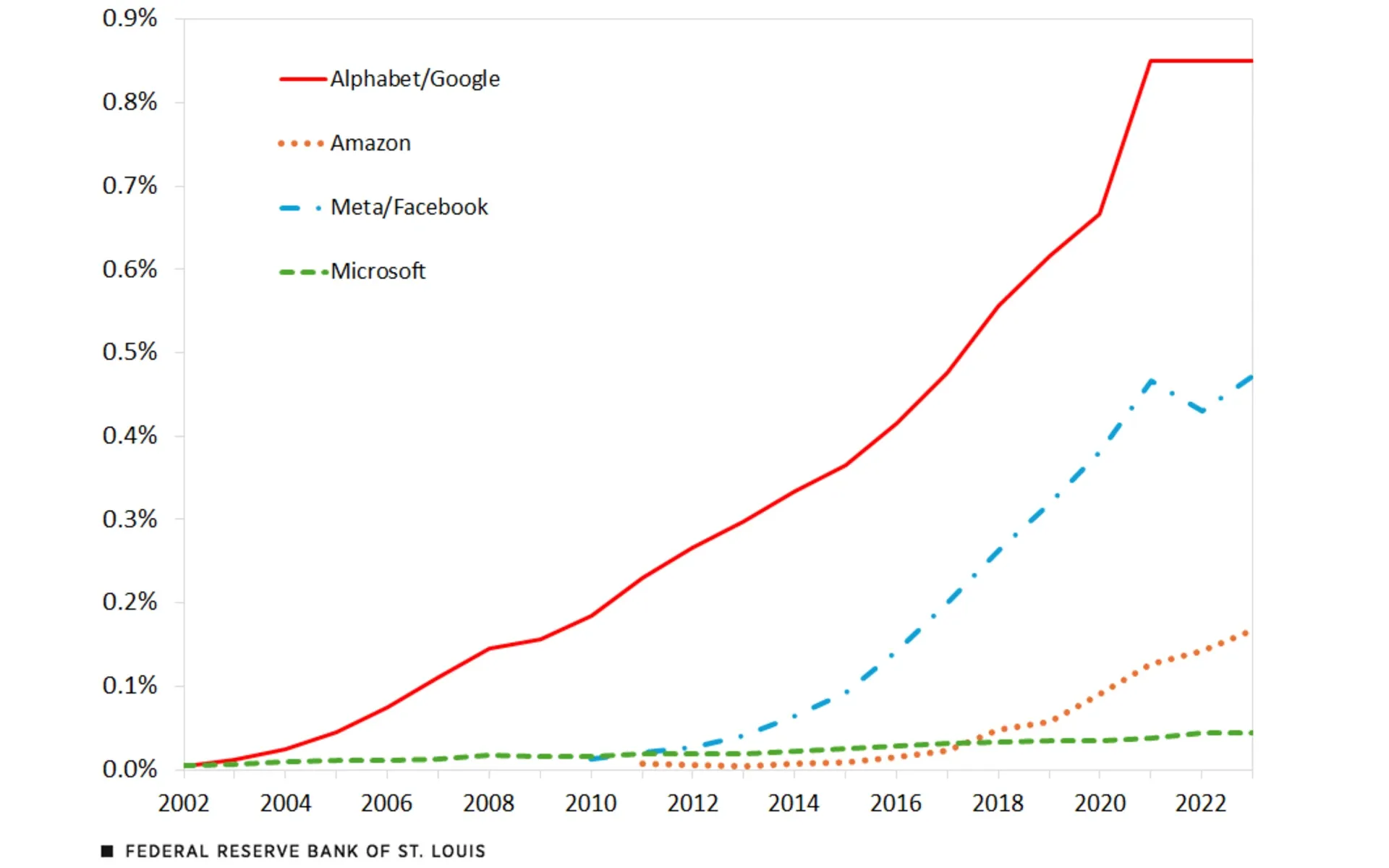Digital advertising is quietly reshaping the U.S. economy
Digital advertising now accounts for up to 1.1% of U.S. GDP, reshaping market dynamics and consumer behavior.

On October 10, 2024, economists Ricardo Marto and Hoang Le published an analysis on the rise of digital advertising and its macroeconomic implications. According to their findings, digital advertising has grown significantly over the past two decades, now representing a substantial portion of the U.S. economy. This growth has not only transformed how businesses reach consumers but also raised questions about market power and consumer welfare.
Digital advertising has become a dominant force in the U.S. economy, accounting for approximately 65% of total advertising spending in recent years. According to data derived from corporate tax returns and historical advertising records compiled by Robert J. Coen, total advertising spending has consistently ranged between 1.3% and 2% of U.S. gross domestic product (GDP) over the past 20 years. In 1994, digital advertising was virtually nonexistent, representing only a tiny fraction of total advertising. However, by 2015, it had grown to about 50% of total advertising spending, and recent estimates suggest it now accounts for closer to 65%.
The widespread adoption of the internet and the proliferation of smartphones have been key drivers of this growth. Digital advertising now represents between 0.6% and 1.1% of U.S. GDP, with big tech companies playing a central role. For example, Alphabet/Google, the largest digital ad platform, generated advertising revenue equivalent to 0.85% of U.S. GDP in 2023. Meta/Facebook accounted for another 0.47%, while Amazon’s digital advertising revenue totaled 0.17% of GDP in the same year.
The rise of digital advertising has had profound effects on both businesses and consumers. According to the analysis, the ability to collect and analyze data on consumer behavior has allowed firms to better infer consumer preferences and tailor their offerings accordingly. From 1995 to 2015, the number of products available to consumers increased by 115%, with technological improvements in digital advertising explaining about 39% of this growth.
This improved targeting has benefits for both consumers and firms. Consumers are more likely to encounter products that match their preferences, while firms can reduce inefficiencies in their marketing efforts. However, the analysis also highlights potential downsides. The ability to infer consumers’ willingness to pay for products may lead to higher markups and increased market power for both product sellers and big tech companies.
The analysis by Marto and Le suggests that digital advertising has contributed to the growing market power of big tech firms. Profit percentages, a measure related to market power, have been significantly higher for these firms compared to the average in the services sector. Between 2002 and 2023, the average profit percentage for firms in the services sector fluctuated around 23%, meaning they earned $1.23 for every $1 spent on producing their services. In contrast, three of the four big tech firms analyzed had profit percentages at least twice as high as the services sector average.
This disparity raises questions about the broader economic implications of digital advertising. While it has enabled firms to offer more targeted products, the extent to which it has concentrated market power among a few dominant players could have long-term consequences for competition and consumer welfare.
One of the key factors driving the growth of digital advertising is the vast amount of data collected through online search and shopping behavior. This data allows firms to refine their advertising strategies and improve the match between what they offer and what consumers want. According to the analysis, this has been a significant factor in the expansion of product varieties available to consumers.
However, the reliance on consumer data also raises concerns about privacy and the potential for misuse. While the analysis does not delve deeply into these issues, it acknowledges that the ability to infer consumer preferences and willingness to pay could lead to higher prices and reduced competition.
Looking ahead, the analysis suggests that the share of digital advertising in U.S. GDP is likely to continue growing. Big tech firms’ financial statements indicate that the market size may already be closer to the upper bound of 1.1% of GDP, and this figure could rise further in the coming years. As digital advertising becomes an even more integral part of the economy, policymakers and regulators will need to carefully consider its implications for market dynamics and consumer welfare.
The analysis by Marto and Le provides a comprehensive overview of the rise of digital advertising and its economic impact. By examining data from corporate tax returns, historical advertising records, and financial statements of major tech firms, they offer valuable insights into how this sector has evolved and what it means for the broader economy. As digital advertising continues to grow, its effects on market power, consumer welfare, and economic efficiency will remain important topics for further research and discussion.
The rise of digital advertising has reshaped the U.S. economy, with significant implications for businesses, consumers, and policymakers. According to the analysis, digital advertising now accounts for up to 1.1% of U.S. GDP, driven by the ability to collect and analyze consumer data. While this has led to more targeted products and increased efficiency, it has also raised concerns about market power and competition. As the sector continues to grow, its economic impact will be an important area of study for economists and policymakers alike.

